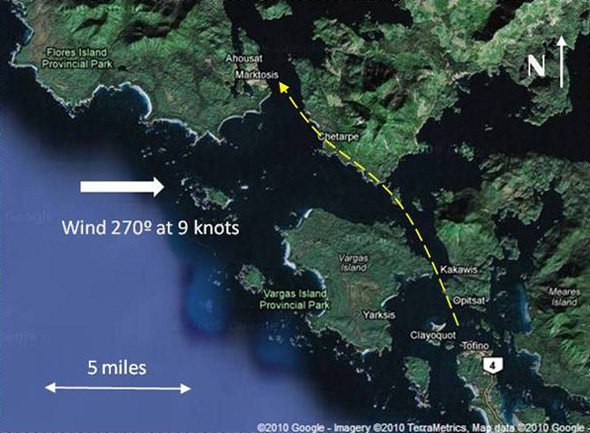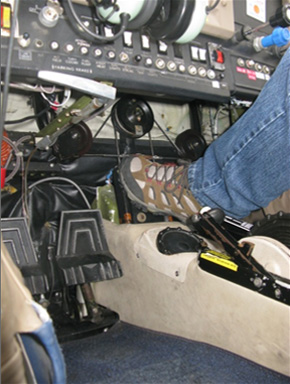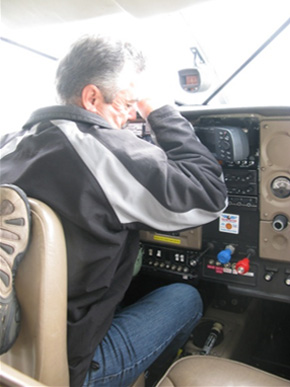Loss of Control – Collision with Water
Atleo River Air Service Ltd.
Cessna 185F, C-GIYQ
Ahousat, British Columbia
The Transportation Safety Board of Canada (TSB) investigated this occurrence for the purpose of advancing transportation safety. It is not the function of the Board to assign fault or determine civil or criminal liability. This report is not created for use in the context of legal, disciplinary or other proceedings. See Ownership and use of content. Masculine pronouns and position titles may be used to signify all genders to comply with the Canadian Transportation Accident Investigation and Safety Board Act (S.C. 1989, c. 3).
Summary
The Atleo River Air Service float-equipped Cessna 185F (serial number 18503618, registration C-GIYQ), took off from Tofino, British Columbia, at 1200 Pacific Daylight Time for a flight to Ahousat, with a pilot and 3 passengers. The short flight was being carried out under visual flight rules at about 500 feet above sea level. About 2 nautical miles from Ahousat, while in cruise flight, the aircraft descended in a steep nose-down attitude until it hit the water in Millar Channel and overturned. Attempts to secure the aircraft failed and it sank. There were no survivors. The emergency locator transmitter functioned but its signal was not received until the wreckage was brought to the surface 2 days later.
Factual information
Other Factual Information
The weather reported at Tofino was as follows: wind 270° true (T) at 9 knots, visibility 8 statute miles, a layer of scattered cloud at 1000 feet above ground level (agl), an overcast layer of cloud at 1400 feet agl, temperature 11°C and dew point 8°C . There were no reports of glassy water or downdrafts along the route of flight at the time of the accident. The 6-minute flight (see Figure 1) is normally flown at 300 to 500 feet above sea level (asl).
The aircraft had been chartered by 3 residents of Ahousat. They had a small amount of baggage and cargo that consisted of several bottles of liquor, a case of beer, and some personal effects. It is unknown where the baggage and cargo were stowed in the aircraft, but they were not secured.
A water taxi service is available for transport between Tofino and Ahousat. The water taxi operator did not allow alcohol to be carried to Ahousat and, consequently, the passengers chartered the aircraft.
The passengers were intoxicated, however they were able to walk and were sufficiently coherent to argue about the price of the charter.
Subsection 602.04(4) of the Canadian Aviation Regulations (CARs) prohibits any operator of an aircraft from allowing a person to board the aircraft where there are reasonable grounds to believe that the person's faculties are impaired by alcohol or a drug to an extent that may present a hazard to the aircraft or to persons on board the aircraft. This provides pilots with the authority to refuse to carry passengers if they have any safety concerns.
The pilot was trained, qualified and certified appropriately for the flight. He was certified as medically fit. The pilot was the company's aircraft maintenance engineer. He did not suffer from any known medical condition that would have induced incapacitation, and there was no evidence to suggest the pilot was depressed or intended to harm himself. He had accumulated about 2000 hours of flying time, mostly in the Cessna 185 on floats operating on the west coast of British Columbia.
The company Cessna 185s were equipped with shoulder restraints, but the pilot was not in the habit of attaching the shoulder restraint strap to the lap belt. He was part owner of 2 private aircraft and they were not equipped with shoulder restraint systems.
The aircraft's weight was determined to have been 332 pounds below the maximum gross take-off weight, and its centre of gravity was at 43.4 inches, which is close to the centre of the range between the forward and aft limits. Dual controls normally installed for co-pilot use were not installed. The aircraft was not equipped with cockpit voice or flight data recording devices and none was required by regulation. Records indicate the aircraft had recently undergone major maintenance, including the replacement of several control cables. It was certified, equipped, and maintained in accordance with existing regulations and approved procedures, except that the seat belts were beyond their 10-year life limit.
Divers found the aircraft wreckage resting on the ocean floor with all the occupants still inside. The pilot was restrained by the lap seat belt; all of the passengers were unrestrained. The right door was ajar. Post-recovery examinations of the wreckage revealed damage indicative of the aircraft striking the water at an attitude of about 45° nose down and the right wing low. There were no indications of control malfunctions. All the control cables were correctly routed and in working condition. The pulleys, trim jacks, and all other control fittings showed no evidence of pre-impact damage. The elevator trim was set at about 5° nose down 1 and the flaps were fully retracted. The aircraft was configured for cruise flight. There was no evidence of engine malfunction. The propeller also showed no evidence of pre-impact malfunction, and it sustained damage consistent with significant power at impact. The engine controls were pushed through the instrument panel and badly damaged from collision forces.
The pilot and front passenger's restraint systems each consisted of a lap belt and a detachable diagonal shoulder restraint strap. The pilot's lap belt showed evidence of high loads consistent with impact forces. While the pilot and the front passenger were about the same weight, there was no evidence of similar loads to the front passenger's lap belt. Neither shoulder restraint strap appeared to have been attached. The rear seats only had lap belts for passenger restraint, and the right rear passenger's lap belt failed under load, indicating that it was being worn at impact. The left rear passenger's lap belt showed no distress.
Pieces of the cardboard beer case and the remnants of several beer cans were found behind the instrument panel, having penetrated near the engine controls. The V brace, which forms a V between the top corners of the windshield and the top centre of the instrument panel, was bent forward.
The autopsies revealed the following information. The pilot did not suffer from a medical event that would have led to incapacitation during the flight. Marks on the pilot and the right rear passenger showed evidence of seat belt use. The pilot sustained a broken right wrist and a severe injury to the forehead with no sign of a strike to the back of the head. The passenger seated directly behind the pilot suffered 2 broken ankles. Toxicology tests revealed high levels of alcohol in all of the passengers.
The front seat passenger died on impact. The pilot and the remaining 2 passengers suffered major injuries that may have been fatal, however, the cause of death was drowning with blunt force as a contributing factor. The injuries to the occupants were such that any post-impact egress attempt would have been impossible or very seriously compromised.
Tests were done to determine if the passengers could have interfered with the aircraft's controls, or the pilot's ability to control the aircraft.
These tests revealed that a person in the passenger front seat can place a foot onto the control system under the instrument panel (see Photo 1), and push the control column forward, thereby causing a nose down control input. In this scenario, however, the pilot can easily overcome the interference.
It was also found that if the pilot's upper body is not secured by the shoulder harness, a rear passenger could push the pilot's seatback forward (see Photo 2) causing the pilot to push the control yoke forward, thereby causing a nose down control input. It was noted that the pilot had no space to leverage his arms and push back sufficiently to overcome the passenger's leg force from behind. In this scenario, a pilot could not resist a push from the back unless it was expected and the pilot braced accordingly.
Analysis
The weather was suitable for the visual flight rules (VFR) flight; the wind direction and speed would not have caused downdrafts or severe turbulence on the flight route. There was no evidence to suggest that any mechanical or environmental issue played a role in this occurrence. Therefore this analysis will explore other scenarios that may explain why the aircraft departed level flight and struck the water.
The aircraft struck the water at an angle and speed consistent with a deliberate dive, or a loss of control. There is no operational reason why the pilot would perform such a manoeuvre. Had the pilot intentionally caused the aircraft to dive, a level-off should have been possible. Based on the pilot's demeanour, there was no reason to dive to the point of impact with the water. Therefore, it is concluded that the pilot lost control of the aircraft.
The aircraft was trimmed for level cruising flight. Had the pilot simply released the controls, the aircraft would have remained more or less in level cruising flight, and it would not have pitched down abruptly or to an angle of 45°. To sustain a descent at a 45° angle from level attitude a high and continued pressure would have had to have been placed on the control column.
The passengers were intoxicated at the time they boarded the aircraft, and had previously been argumentative. The final location of some beer cans and fragments of the beer case indicate that the case of beer was in proximity to the passengers just before impact.
It is not known if all the passengers were wearing their seat belts at the start of the flight, but the physical evidence shows that the seatbelts of the passenger in the right front seat (beside the pilot) and of the passenger in the left rear seat (behind the pilot) were not fastened at impact.
What was happening in the cabin moments before the pilot lost control cannot be accurately determined. However, it can be concluded that this probably involved activity by the unsecured passengers that interfered with the pilot and his control of the aircraft.
The pilot's broken right wrist and the bent V brace suggest that the pilot was bracing or trying to resist a force imposed from behind. The broken ankles of the passenger behind the pilot are consistent with that person bracing with both feet, or pushing forward with both feet, at the time of impact. It is possible the passenger seated behind the pilot kicked the pilot's seatback forward and held it there, pushing the pilot into the instrument panel and the controls forward thereby inducing a dive.
Because there was no locking mechanism on the pilot's seatback, and because the pilot was not wearing his shoulder strap, he would have been unable to prevent his upper body from being forced onto the instrument panel.
When aircraft controls are accessible to passengers there is a risk of inadvertent control manipulation and a risk of the pilot losing control of the aircraft at a critical time of flight operations.
It is also possible the level of the passengers' intoxication impaired their ability 2 to recognize the gravity of the situation and stop their interference in time for the pilot to regain control of the aircraft before impact.
Findings
Findings as to causes and contributing factors
- It is likely that passenger interference caused the pilot to lose control of the aircraft whereupon it descended in a steep nose-down attitude until it struck the water.
- It is possible the passengers' level of intoxication contributed to their inability to recognize the gravity of the situation and stop the interference in time for the pilot to regain control of the aircraft before impact.
- Because there was no locking mechanism on the pilot's seatback, and because the pilot was not wearing his shoulder strap, he would have been unable to prevent his upper body from being forced onto the instrument panel.
- When controls are accessible to passengers there is a risk of inadvertent control manipulation and a risk of the pilot losing control of the aircraft.
- When upper body restraint systems are not used there is a risk of serious head injury in the event of an accident.
- When cargo or passengers' baggage is not restrained, there is a risk of unsecured items injuring persons on board in the event of sudden aircraft stoppage or encounters with severe turbulence.
Other Finding
- Post-impact survival issues such as egress and flotation were not relevant in this accident.
This report concludes the Transportation Safety Board's investigation into this occurrence. Consequently, the Board authorized the release of this report on .


